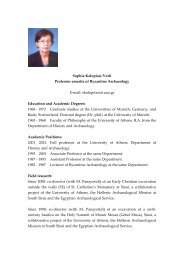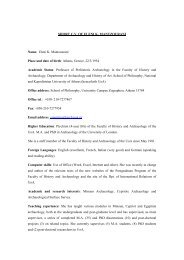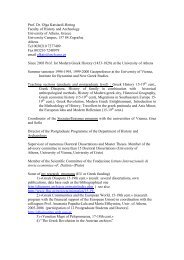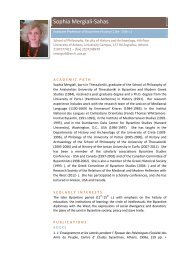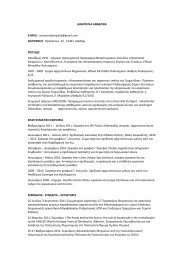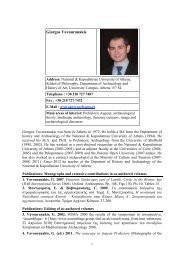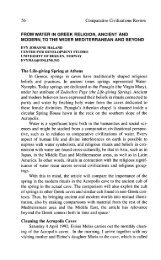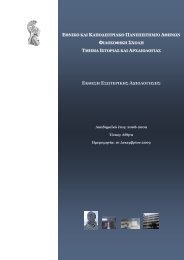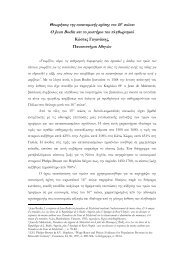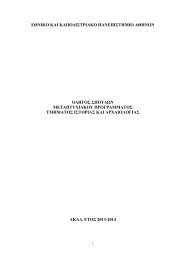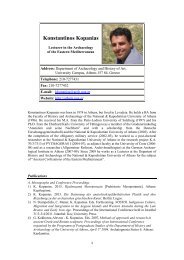OLGA PALAGIA The Marble of the Penelope from Persepolis and Its ...
OLGA PALAGIA The Marble of the Penelope from Persepolis and Its ...
OLGA PALAGIA The Marble of the Penelope from Persepolis and Its ...
You also want an ePaper? Increase the reach of your titles
YUMPU automatically turns print PDFs into web optimized ePapers that Google loves.
1st INTERNATIONAL CONFERENCE<br />
Ancient Greece <strong>and</strong> Ancient Iran<br />
Cross-Cultural Encounters<br />
ATHENS, 11-13 NOVEMBER 2006<br />
Edited by Seyed Mohammad Reza Darb<strong>and</strong>i <strong>and</strong> Antigoni Zournatzi<br />
0;h<br />
&<br />
1 [ [I 10<br />
Hellenic National Cultural Center <strong>of</strong> <strong>the</strong> Embassy<br />
Research Foundation = Cornrniss~on for UNESCO <strong>of</strong> <strong>the</strong> Islamic Republic <strong>of</strong> Iran<br />
A<strong>the</strong>ns 2008
<strong>OLGA</strong> <strong>PALAGIA</strong><br />
<strong>The</strong> <strong>Marble</strong> <strong>of</strong> <strong>the</strong> <strong>Penelope</strong> <strong>from</strong> <strong>Persepolis</strong><br />
<strong>and</strong> <strong>Its</strong> Historical Implications<br />
LIFE-SIZE Greek lady in <strong>the</strong> Severe Style was excavated in Persepo-<br />
A lis by <strong>the</strong> Oriental Institute <strong>of</strong> Chicago in 1945 <strong>and</strong> is now in <strong>the</strong> Archaeological<br />
Museum <strong>of</strong> Tehran (inv. no. 1538) (~i~s. 1-2). It lay scattered in<br />
three fragments in <strong>the</strong> ruins <strong>of</strong> <strong>the</strong> <strong>Persepolis</strong> Treasury, headless torso lying<br />
in Corridor 31, shattered right h<strong>and</strong> in Hall 38,' <strong>The</strong> circumstances <strong>of</strong> discovery<br />
recall <strong>the</strong> destruction <strong>of</strong> <strong>Persepolis</strong> by Alex<strong>and</strong>er <strong>the</strong> Great in<br />
spring 330 BC (Arr., Anab. 3.18.11-12). Before torching <strong>the</strong> palace, Alex<strong>and</strong>er<br />
removed <strong>the</strong> gold stored in <strong>the</strong> Treasury <strong>and</strong> allowed his army to plunder<br />
<strong>the</strong> rest <strong>of</strong> its contents. According to Curtius' graphic description<br />
(5.6.5), '[<strong>the</strong> soldiers] hacked to pieces with axes vases that were precious<br />
works <strong>of</strong> art . . . Statues were dismembered <strong>and</strong> individuals dragged away<br />
<strong>the</strong> limbs <strong>the</strong>y had broken <strong>of</strong>f'. This explains why <strong>the</strong> rest <strong>of</strong> <strong>the</strong> statue was<br />
never found: it was probably carried away as a souvenir. It is interesting<br />
that <strong>the</strong> obvious Greek provenance <strong>of</strong> <strong>the</strong> statue did not save it <strong>from</strong> destruction.<br />
<strong>Its</strong> placement in <strong>the</strong> Treasury is no less intriguing, Gift or loot?<br />
This question has always haunted scholarship on <strong>the</strong> statue. But new evidence<br />
has come to light that may help resolve <strong>the</strong> problem.<br />
Arrian (Anab. 6.30.1) reports that when Alex<strong>and</strong>er returned to <strong>Persepolis</strong><br />
in 324 he regretted his action. And when <strong>the</strong> ambassadors <strong>of</strong> <strong>the</strong> Greek<br />
cities came to see him at Babylon shortly <strong>the</strong>reafter, he went so far as to<br />
promise repatriation for a number <strong>of</strong> statues looted by Darius I <strong>and</strong> Xerxes<br />
<strong>from</strong> Ionia <strong>and</strong> Greece in <strong>the</strong> 490s <strong>and</strong> 480s (7.19.2). <strong>The</strong>se included <strong>the</strong><br />
bronze Apollo Philesios by Kanachos, taken <strong>from</strong> Miletus in 493 in retaliation<br />
for <strong>the</strong> Ionian revolt, <strong>the</strong> bronze vrannicides by Antenor, a statue <strong>of</strong><br />
Figs. 1-2<br />
<strong>Penelope</strong> <strong>from</strong> <strong>Persepolis</strong>.<br />
Tehran Museum 1538.<br />
Plaster cast in Berlin,<br />
Abguss-Sammlung Antiker<br />
Plastik <strong>of</strong> <strong>the</strong> Freie<br />
Universitat.<br />
Photos: H. R. Goette.<br />
THE MARBLE OF THE PENELOPE FROM PERSEWLIS AND ITS HISTORICAL IMPLICATIONS 223
Flg. 3<br />
Poseidon, Apollo <strong>and</strong><br />
Artemis. Par<strong>the</strong>non east<br />
frieze. Acropolis Museum<br />
856. Photo: 0. Palagia.<br />
Artemis Kelkaia, <strong>and</strong> a bronze statuette <strong>of</strong> a female water-carrier dedicat-<br />
ed by <strong>The</strong>mistokles, all plundered <strong>from</strong> A<strong>the</strong>ns in 479, <strong>and</strong> a cult statue <strong>of</strong><br />
Artemis removed <strong>from</strong> Brauron at <strong>the</strong> same time. Those statues were dis-<br />
tributed to various centres <strong>of</strong> <strong>the</strong> Great King's domain, Sardis, Ecbatana,<br />
Susa, Pasargadae, Babylon <strong>and</strong> <strong>Persepolis</strong>. We do not know if <strong>the</strong>y were<br />
placed on public display, with <strong>the</strong> exception <strong>of</strong> <strong>The</strong>mistokles' Water-Carri-<br />
er, which ended up in <strong>the</strong> sanctuary <strong>of</strong> <strong>the</strong> Mo<strong>the</strong>r <strong>of</strong> <strong>the</strong> Gods at Sardis.<br />
<strong>The</strong> exiled <strong>The</strong>mistokles tried to persuade <strong>the</strong> satrap <strong>of</strong> Lydia to return it<br />
to A<strong>the</strong>ns, but his request was turned down. <strong>The</strong> Tyrannicides were prob-<br />
ably repatriated after Alex<strong>and</strong>er's death, ei<strong>the</strong>r by Seleucus I or his son<br />
Antiochos I; Seleucus was also responsible for <strong>the</strong> return <strong>of</strong> <strong>the</strong> Apollo<br />
Philesios to Miletu~.~<br />
<strong>The</strong> penelope <strong>of</strong> <strong>Persepolis</strong> sits on a stool, legs crossed, head bent (Figs.<br />
1-2). She wears a chiton <strong>and</strong> a himation covering her head, back <strong>and</strong> lower<br />
body. <strong>The</strong> head with <strong>the</strong> neck, both forearms, left h<strong>and</strong>, lower legs <strong>and</strong> feet,<br />
along with most <strong>of</strong> <strong>the</strong> seat, are missing. <strong>The</strong> fragmentary right h<strong>and</strong> has a<br />
groove running along <strong>the</strong> palm, indicating that it held a rod-like metallic<br />
object, now lost.3 <strong>The</strong> stool was placed on top <strong>of</strong> a wool basket: <strong>the</strong> round<br />
outline <strong>of</strong> its shaft is now visible underneath <strong>the</strong> seat.4 <strong>The</strong> stool was<br />
pieced, its underside carrying anathyrosis <strong>and</strong> circular holes for attachment<br />
on ei<strong>the</strong>r side. Three holes remain at <strong>the</strong> rear, two in front, but <strong>the</strong>ir origi-<br />
nal number is unknown. <strong>The</strong> figure is composed as a relief, with only one<br />
good view, showing her torso frontal while <strong>the</strong> legs <strong>and</strong> right arm are in<br />
pr<strong>of</strong>ile. <strong>The</strong> pose is ahkward but <strong>the</strong> drapery in front appears sophisticat-<br />
ed, especially <strong>the</strong> loose ends <strong>of</strong> <strong>the</strong> chiton folds over her midriff <strong>and</strong> <strong>the</strong> hi-<br />
mationdraped over <strong>the</strong> thighs. This transition <strong>from</strong> <strong>the</strong> old to <strong>the</strong> new is a<br />
characteristic <strong>of</strong> <strong>the</strong> Severe Style. <strong>The</strong> drapery over her torso anticipates<br />
<strong>the</strong> gods on <strong>the</strong> east frieze <strong>of</strong> <strong>the</strong> Par<strong>the</strong>non, especially Artemis (Fig. 3); but<br />
her stiff pose <strong>and</strong> flat composition indicate an earlier phase closer to <strong>the</strong><br />
metopes <strong>of</strong> <strong>the</strong> temple <strong>of</strong> Zeus at Ol~mpia.~<br />
<strong>The</strong> statuary type had long been known <strong>from</strong> two headless marble<br />
sculptures <strong>of</strong> <strong>the</strong> Roman imperial period. Both were found in Rome <strong>and</strong><br />
are now in <strong>the</strong> Vatican Museum. In <strong>the</strong> Galleria delle Statue, a statue <strong>of</strong> a<br />
figure sitting on a rock has been restored with a non-pertinent head ( ~ i 4), ~ .<br />
while a fragmentary relief in <strong>the</strong> Museo Gregoriano Pr<strong>of</strong>ano (formerly in
<strong>the</strong> Museo Chiaramonti) ( ~ i 5) ~ . preserves <strong>the</strong> wool basket <strong>and</strong> <strong>the</strong> left<br />
h<strong>and</strong> resting on ita6 In 1891 Studniczka associated <strong>the</strong> ex Chiaramonti relief<br />
with a Severe Style head in Berlin (~i~s. 6-7), also <strong>from</strong> Rome, showing a<br />
woman leaning her head on what appear to be <strong>the</strong> remnants <strong>of</strong> her right<br />
h<strong>and</strong>.' <strong>The</strong> Berlin head wears a broad headb<strong>and</strong>, probably a sakkos, underneath<br />
a himation drawn up over her head. <strong>The</strong> bangs over her forehead<br />
recall <strong>the</strong> hairstyle <strong>of</strong> <strong>the</strong> Severe Style Artemision God.g <strong>The</strong>re are two<br />
o<strong>the</strong>r copies <strong>of</strong> <strong>the</strong> head, both with a Roman provenance, one in Copenhagen<br />
<strong>and</strong> <strong>the</strong> o<strong>the</strong>r, heavily battered, in <strong>the</strong> Museo Nazionale in Rome.g<br />
<strong>The</strong> head in <strong>the</strong> Museo Nazionale has a flat surface on <strong>the</strong> right side <strong>of</strong> <strong>the</strong><br />
head for <strong>the</strong> attachment <strong>of</strong> a separtely carved h<strong>and</strong>. Sadly, all three copies<br />
<strong>of</strong> <strong>the</strong> head lack <strong>the</strong>ir noses.<br />
Studniczka's reconstruction shows her leaning her head on her right<br />
h<strong>and</strong> in an attitude <strong>of</strong> dejection, left h<strong>and</strong> resting on <strong>the</strong> stool ( ~i~. 8). Variants<br />
<strong>of</strong> this reconstruction combining different elements <strong>of</strong> <strong>the</strong> various<br />
copies were produced by Treu (1882-1916), Langlotz (1961) <strong>and</strong> Gauer<br />
Fig. 4<br />
<strong>Penelope</strong>. Vatican Museum<br />
$4. Plaster cast in Basel,<br />
~kulpturhalle.<br />
Photo: H. R. Goette.<br />
<strong>Penelope</strong>. Vatican Museum<br />
1558. Plaster cast in Munich,<br />
Museum fiir Abgiisse<br />
Klassischer Bildwerke.<br />
Photo: Museum.<br />
Fig. 6<br />
Head <strong>of</strong> <strong>Penelope</strong>. Berlin,<br />
Staatliche Museen Sk 603.<br />
Photo: G. Gens (FA<br />
Cologne, Arachne, neg. no.<br />
Sperg 000522-01-2270).<br />
m7<br />
Head <strong>of</strong> <strong>Penelope</strong>. Berlin,<br />
Staatliche Museen Sk 603.<br />
Photo: G. Gens (FA<br />
Cologne, Arachne, neg. no.<br />
Sperg 000522-05-2270.4).<br />
THE MARBLE OFTHE PENELOPE FROM PERSEPOLlS AND ITS HISTORICAL IMPLICATIONS 225
Fig. 8<br />
Studniczka's reconstruction<br />
<strong>of</strong> <strong>Penelope</strong>. (After<br />
Studninka 1891: 17.)<br />
Fig. 9<br />
Plaster reconstruction <strong>of</strong><br />
<strong>Penelope</strong> in Munich,<br />
Museum fur Abgusse<br />
Klassischer Bildwerke.<br />
Photo: Museum.<br />
226 <strong>OLGA</strong> PALAGM<br />
(1990).1° <strong>The</strong> motif <strong>of</strong> <strong>the</strong> head leaning on <strong>the</strong> h<strong>and</strong> was challenged by Stahler,<br />
who was <strong>the</strong> first scholar to take account <strong>of</strong> <strong>the</strong> groove in <strong>the</strong> right palm<br />
<strong>of</strong> <strong>the</strong> <strong>Persepolis</strong> statue." He reached <strong>the</strong> conclusion that her right h<strong>and</strong><br />
held out a wreath by comparison with a later variant represented on a<br />
stater <strong>from</strong> <strong>The</strong>bes <strong>from</strong> c. 446-426 BC, showing a seated woman holding<br />
out a helmet in her left h<strong>and</strong>, right h<strong>and</strong> placed on hip.12 But <strong>the</strong> metallic,<br />
rod-like object in <strong>Penelope</strong>'s right h<strong>and</strong> need not rule out its traditional<br />
placement on <strong>the</strong> right cheek. A new reconstruction in plaster created for<br />
<strong>the</strong> Museum fiir Abgiisse klassischer Bildwerke in Munich adds a spindle<br />
in <strong>the</strong> right h<strong>and</strong> supporting <strong>the</strong> head, thus identifying <strong>the</strong> figure with<br />
<strong>Penelope</strong> ( ~ i 9).13 ~ .<br />
<strong>The</strong> prototype most probably did represent grieving <strong>Penelope</strong> waiting<br />
for Odysseus,I4 judging by <strong>the</strong> numerous reproductions in o<strong>the</strong>r media that<br />
circulated in <strong>the</strong> fifth century. It was obviously both popular <strong>and</strong> accessible,<br />
inspiring a spate <strong>of</strong> reproductions in a wide range <strong>of</strong> regions, <strong>the</strong> earliest<br />
dating <strong>from</strong> 460 BC.I5 Only a few examples need be cited here. A number<br />
<strong>of</strong> clay 'Melian' reliefs combine her with Odysseus <strong>and</strong> o<strong>the</strong>r figures at <strong>the</strong><br />
moment <strong>of</strong> recognition.16 A gold ring in New York naming her in <strong>the</strong> Dorian<br />
dialect (HANEAOIIA) includes Odysseus' bow thus evoking <strong>the</strong> slaying<br />
<strong>of</strong> <strong>the</strong> suitors.I7 An Attic red-figure skyphos <strong>of</strong> c. 440 in Chiusi represents<br />
her in front <strong>of</strong> her loom, attended by her son Telemachos, while <strong>the</strong> o<strong>the</strong>r<br />
side shows Odysseus being recognized by <strong>the</strong> old servant washing his feet.ls<br />
This vase has prompted <strong>the</strong> suggestion that <strong>the</strong> seated <strong>Penelope</strong> was invented<br />
by a famous Severe Style painter <strong>and</strong> was subsequently adapted into<br />
o<strong>the</strong>r media.lg<br />
In <strong>the</strong> second quarter <strong>of</strong> <strong>the</strong> fifth century Polygnotos <strong>of</strong> Thasos painted<br />
a series <strong>of</strong> works inspired by <strong>the</strong> life <strong>of</strong> Odysseus, a Nekyia or Descent into<br />
<strong>the</strong> Underworld for <strong>the</strong> Lesche <strong>of</strong> <strong>the</strong> Cnidians at Delphi (Paus. 10.28-31),<br />
Odysseus stealing <strong>the</strong> bow <strong>of</strong> Philoktetes on Lemnos for A<strong>the</strong>ns (Paus.<br />
1.22.6), <strong>and</strong> Odysseus slaying <strong>the</strong> suitors for <strong>the</strong> temple <strong>of</strong> A<strong>the</strong>na Areia at<br />
Plataea (Paus. 9.4.1). He may have painted fur<strong>the</strong>r Odysseus <strong>the</strong>mes, for
example at <strong>The</strong>spiai, where we are told that a work <strong>of</strong> his <strong>of</strong> unknown subject<br />
was restored by Pausias in <strong>the</strong> fourth century BC (Plin. HN 35.123). A<br />
seated <strong>Penelope</strong> contemplating her fate could easily have formed part <strong>of</strong><br />
any number <strong>of</strong> Odysseus compositions. It has been suggested that <strong>the</strong> pictorial<br />
prototype <strong>of</strong> <strong>the</strong> seated <strong>Penelope</strong> was invented by Polygnotos in his<br />
painting at <strong>The</strong>spiai." But o<strong>the</strong>r possibilities present <strong>the</strong>mselves, not least<br />
a picture <strong>of</strong> <strong>the</strong> massacre <strong>of</strong> <strong>the</strong> suitors, with which indeed she seems to be<br />
associated on <strong>the</strong> New York ring on account <strong>of</strong> <strong>the</strong> addition <strong>of</strong> Odysseus'<br />
bow. <strong>The</strong> attribution <strong>of</strong> <strong>the</strong> <strong>Penelope</strong> prototype to Polygnotos is an attractive<br />
suggestion that goes back a long way <strong>and</strong> has met with wide acceptance.<br />
In addition, Pliny (HN 34.85) reports <strong>the</strong> little-known fact that Polygnotos<br />
was not only a famous painter but also a bronze sculptor. It is not unlikely<br />
that he may have turned his own design into a statue. But this remains<br />
in <strong>the</strong> realm <strong>of</strong> speculation.<br />
<strong>The</strong> appearance <strong>of</strong> an 'original' Greek marble version at <strong>Persepolis</strong> has<br />
generated endless discussion as to its provenance, date, <strong>and</strong> relation to <strong>the</strong><br />
Roman copies <strong>and</strong> adaptations, which were obviously based on ano<strong>the</strong>r<br />
original that survived into <strong>the</strong> Roman imperial peri0d.2~ A case <strong>of</strong> two<br />
identical originals is attested before this time by <strong>the</strong> bronze Apollo Milesios<br />
by Kanachos, carried away by Darius I in 493 BC, <strong>and</strong> its wooden contemporary<br />
replica by <strong>the</strong> same artist in <strong>The</strong>besu One assumes a duplicate<br />
dedication, especially as later replicas <strong>of</strong> earlier types are unheard <strong>of</strong> in <strong>the</strong><br />
archaic <strong>and</strong> classical periodsz3 Such retrospective tendencies are only common<br />
<strong>from</strong> <strong>the</strong> first century BC onwards.<br />
<strong>The</strong> <strong>Persepolis</strong> statue (Rg. 1) has been considered a marble copy <strong>of</strong> a<br />
bronze original or a second marble original. <strong>The</strong>re is no consensus over its<br />
date. Most scholars place her in <strong>the</strong> decade 460-450 BC but she is probably<br />
closer to <strong>the</strong> mid-fifth century on account <strong>of</strong> her affinity to <strong>the</strong> Par<strong>the</strong>non<br />
frieze. A minority view considers her ei<strong>the</strong>r a High Classical or a Rich<br />
Style imitation <strong>of</strong> a Severe Style prototype despite <strong>the</strong> fact that we have<br />
no evidence <strong>of</strong> reproductions <strong>of</strong> Severe Style originals in <strong>the</strong> second half<br />
<strong>of</strong> <strong>the</strong> fifth century.24 <strong>The</strong> more 'archaic' appearance <strong>of</strong> <strong>the</strong> Roman copies<br />
has prompted <strong>the</strong> suggestion that <strong>the</strong> <strong>Persepolis</strong> statue was created one,<br />
two or more decades after <strong>the</strong> putative prototype which is reflected in <strong>the</strong><br />
Vatican copies. It is not safe, however, to make stylistic arguments based<br />
on Roman copies, as <strong>the</strong>se may be contaminated by retrospection or o<strong>the</strong>r<br />
tendencies. <strong>The</strong> stylistic differences detected between <strong>the</strong> <strong>Persepolis</strong><br />
torso <strong>and</strong> <strong>the</strong> Roman copies need not reflect two originals created at different<br />
times but may be attributed to <strong>the</strong> whims <strong>of</strong> <strong>the</strong> copyists. On present<br />
evidence, it is safer to assume that two versions <strong>of</strong> <strong>the</strong> <strong>Penelope</strong> were<br />
created at <strong>the</strong> same time, that is, around <strong>the</strong> middle <strong>of</strong> <strong>the</strong> fifth century, in<br />
order to be set up at different locations.25 Because <strong>the</strong> <strong>Persepolis</strong> statue<br />
was created long after <strong>the</strong> Persian raids <strong>of</strong> <strong>the</strong> first quarter <strong>of</strong> <strong>the</strong> fifth century,<br />
it was probably not loot but a gift <strong>from</strong> a Greek city to <strong>the</strong> Great<br />
<strong>The</strong> historical context may well be mounting opposition against<br />
A<strong>the</strong>nian oppression in <strong>the</strong> middle years <strong>of</strong> <strong>the</strong> century, when <strong>the</strong> Delian<br />
League was gradually transformed into an A<strong>the</strong>nian empire. After <strong>the</strong> disaster<br />
<strong>of</strong> <strong>the</strong> A<strong>the</strong>nian fleet in Egypt in <strong>the</strong> mid-450s <strong>the</strong>re were movements<br />
<strong>of</strong> rapprochement between Ionian cities <strong>and</strong> <strong>the</strong> Persians, e.g., Erythrai<br />
<strong>and</strong> Milet~s.~~ In 440139 Samos solicited Persian support in its attempt to<br />
secede <strong>from</strong> <strong>the</strong> A<strong>the</strong>nian allianceZs <strong>and</strong> <strong>the</strong>re may have been o<strong>the</strong>r, unrecorded<br />
cases <strong>of</strong> allies looking eastward.
Fig. 10<br />
<strong>Marble</strong> <strong>of</strong> <strong>Penelope</strong> Figs. 1-2<br />
Photo: British Museum.<br />
228 <strong>OLGA</strong> PALACIA<br />
<strong>The</strong> origin <strong>of</strong> <strong>the</strong> <strong>Persepolis</strong> statue has been tentatively placed on an<br />
unspecified Greek isl<strong>and</strong> or on Samos, in Cyzicus, Colophon, Phocaea,<br />
<strong>The</strong>ssaly, Sparta, even A<strong>the</strong>ns.29 Despite <strong>the</strong> fact that <strong>the</strong>re was no Severe<br />
Style in East Greece, her style is <strong>of</strong>ten described as 10nian.~~ Because <strong>the</strong><br />
motif <strong>of</strong> <strong>the</strong> woman seated in dejection was later adapted to represent a<br />
variety <strong>of</strong> figures, like Electra on 'Melian' plaques or Demeter on <strong>the</strong><br />
Par<strong>the</strong>non frieze <strong>and</strong> possibly o<strong>the</strong>r local deities <strong>and</strong> personifications,3'<br />
<strong>the</strong> identification <strong>of</strong> <strong>the</strong> <strong>Persepolis</strong> statue with <strong>Penelope</strong> has been questioned.<br />
She has been interpreted instead as Aphrodite mourning for Adonis,<br />
perhaps dedicated at Phocaea by A~pasia;~* as a city personification<br />
like Larissa, created by <strong>the</strong> Phocaean artist Telephanes for <strong>the</strong> <strong>The</strong>s-<br />
~alians;~~ as Hellas waiting to be liberated <strong>from</strong> <strong>the</strong> Persians by <strong>the</strong> A<strong>the</strong>nians<br />
<strong>and</strong> <strong>the</strong>ir allies34 or to be rid <strong>of</strong> A<strong>the</strong>nian domination with <strong>the</strong> assistance<br />
<strong>of</strong> Persia3s or as Eleu<strong>the</strong>ria ('Freedom') on <strong>the</strong> evidence <strong>of</strong> a fourthcentury<br />
coin type <strong>from</strong> Cyzicus." In sum, its findspot in <strong>the</strong> <strong>Persepolis</strong><br />
Treasury has affected <strong>the</strong> interpretation <strong>of</strong> its iconography, which has been<br />
invested with a political significance.<br />
<strong>The</strong>re is, however, one factor that has not been taken into consideration<br />
in <strong>the</strong> discussion <strong>of</strong> <strong>the</strong> <strong>Persepolis</strong> statue, <strong>and</strong> that is <strong>the</strong> provenance <strong>of</strong> its<br />
marble. Olmstead, who first published <strong>the</strong> torso, identified it as Greek isl<strong>and</strong><br />
marble." This was contested by Langlotz, who remarked that <strong>the</strong> marble<br />
is .similar to that <strong>of</strong> many sculptures <strong>from</strong> Ephesus <strong>and</strong> <strong>the</strong>refore must<br />
come <strong>from</strong> that area.% Discussion <strong>of</strong> <strong>the</strong> marble soon stopped as o<strong>the</strong>r<br />
scholars only knew <strong>the</strong> statue <strong>from</strong> plaster casts in European collections or<br />
<strong>from</strong> photographs. <strong>The</strong> present writer had <strong>the</strong> opportunity to view <strong>the</strong> statue<br />
while it was on display on <strong>the</strong> loan exhibition 'Forgotten Empire. <strong>The</strong><br />
World <strong>of</strong> Ancient Persia' in <strong>the</strong> British Museum in autumn 2005. <strong>The</strong><br />
coarse-grained white marble ( ~ i 10) ~ . with its sugary, sparkling texture can<br />
be readily distinguished as <strong>the</strong> dolomitic marble quarried at Cape Vathy on<br />
<strong>the</strong> isl<strong>and</strong> <strong>of</strong> Thasos in nor<strong>the</strong>rn Greece. In <strong>the</strong> absence <strong>of</strong> scientific tests<br />
determining its provenance, one can only compare its appearance to o<strong>the</strong>r
sculptures in Thasian marble in Greek museums, for example a grave relief<br />
<strong>from</strong> Dikaia in Thrace in <strong>the</strong> A<strong>the</strong>ns National Museum (inv. no. 40) ( ~ i ~ .<br />
Thasian marble was widely exported in <strong>the</strong> Roman empire <strong>and</strong> ex-<br />
tensively employed for <strong>the</strong> Roman sculptures at Ephesus (for example, in<br />
<strong>the</strong> Parthian Monument),4O which explains why Langlotz believed it was lo-<br />
cal. It was not, however, much exported in <strong>the</strong> sixth <strong>and</strong> fifth centuries BC,<br />
except to <strong>the</strong> Greek cities on <strong>the</strong> Thracian coast, for example, Neapolis<br />
(modern Kavala), Abdera, Dikaia <strong>and</strong> Maroneia. <strong>The</strong> sculptural produc-<br />
tion <strong>of</strong> <strong>the</strong>se cities was very limited at that time <strong>and</strong> is usually credited to<br />
Thasian workshops.41 A probable Thasian work carved in Thasian marble<br />
is a Severe Style grave relief <strong>from</strong> Komotini in <strong>the</strong> Archaeological Muse-<br />
um <strong>of</strong> <strong>The</strong>ssaloniki (inv, no. 1251).42 It has been suggested that Thasian<br />
marble also found a market in Magna Graecia in <strong>the</strong> fifth century, but <strong>the</strong><br />
few Thasian marble sculptures assigned to South Italy are in fact pieces <strong>of</strong><br />
doubtful provenance in American museums.43 Until fur<strong>the</strong>r evidence be-<br />
comes available, <strong>the</strong> South Italian connection remains sub judice.<br />
In sum, if <strong>the</strong> <strong>Persepolis</strong> statue is in Thasian marble, it must come <strong>from</strong><br />
a Thasian workshop which operated ei<strong>the</strong>r on <strong>the</strong> isl<strong>and</strong> or in <strong>the</strong> cities on<br />
<strong>the</strong> opposite coast. What do we know <strong>of</strong> Thasian sculpture in <strong>the</strong> Severe<br />
Style? Not much. Apart <strong>from</strong> a fine banquet relief in a style related to that<br />
<strong>of</strong> Paros, now in <strong>the</strong> Istanbul Museum (inv. no. 1947)," we hear <strong>from</strong> Pau-<br />
sanias (5.25.12-13; 6.11.2) <strong>of</strong> bronze statues <strong>of</strong> Herakles <strong>and</strong> <strong>the</strong> Olympic vic-<br />
tor <strong>The</strong>agenes dedicated by <strong>the</strong> Thasians at Olympia, probably in <strong>the</strong> sec-<br />
ond quarter <strong>of</strong> <strong>the</strong> fifth century. Bronze sculptural production indicates<br />
prosperity. Thasian history in <strong>the</strong> fifth century is marked by <strong>the</strong> struggle to<br />
stave <strong>of</strong>f <strong>the</strong> encroachment <strong>of</strong> A<strong>the</strong>ns, in an effort to maintain control <strong>of</strong><br />
<strong>the</strong> gold mines on Mount Pangaion in Thrace. Thasos' revolt <strong>from</strong> <strong>the</strong><br />
Delian League in 465 ended in disaster. After a three-year siege <strong>and</strong> a vain<br />
appeal to Sparta for help, Thasos surrendered to Kimon in 463 <strong>and</strong> gave up<br />
its dependencies on Thra~e.~~ Financial recovery seems to have returned<br />
sometime between 446 <strong>and</strong> 444, when Thasos' annual tribute to <strong>the</strong> Al-<br />
Fig. 11<br />
Stele <strong>from</strong> Dikaia. A<strong>the</strong>ns,<br />
National Museum 40. '.<br />
Photo: 0. Palagia. '*
Rg. 12<br />
Boston Throne. Boston,<br />
Museum <strong>of</strong> Fine Arts 08.205.<br />
Photo before over-cleaning.<br />
Ashmole Archive. King's<br />
College, London.<br />
Fig. 13<br />
Boston Throne. Boston,<br />
Museum <strong>of</strong> Fine Arts 08.205.<br />
Photo before over-cleaning.<br />
Ashmole Archive. King's<br />
College, London.<br />
liance rose steeply <strong>from</strong> 3 to 30 talents.46 It was precisely at that time that<br />
<strong>the</strong> most famous Thasian artist <strong>of</strong> all time, <strong>the</strong> painter Polygnotos, returned<br />
to settle on <strong>the</strong> isl<strong>and</strong>, as is indicated by <strong>the</strong> lists <strong>of</strong> <strong>the</strong>oroi <strong>from</strong> <strong>the</strong> 440s4'<br />
If <strong>the</strong> statue <strong>of</strong> <strong>Penelope</strong> was created by a Thasian workshop, <strong>the</strong>n it<br />
cannot have been plundered by <strong>the</strong> Persians, who did not raid ei<strong>the</strong>r Thasos<br />
or <strong>the</strong> opposite coast in <strong>the</strong> mid-fifth century. Xerxes <strong>and</strong> his army were<br />
lavishly entertained on <strong>the</strong> isl<strong>and</strong> when making <strong>the</strong>ir way to Greece in 480<br />
BC.48 <strong>The</strong> memory <strong>of</strong> good relations presumably remained, <strong>and</strong> <strong>the</strong> <strong>Persepolis</strong><br />
statue could conceivably have been <strong>of</strong>fered as a gift to his successor,<br />
Artaxerxes I. This would have constituted an act <strong>of</strong> defiance against Thasos'<br />
A<strong>the</strong>nian allies, perhaps a secret attempt to curry favour with <strong>the</strong> Persians,<br />
an attempt that has eluded our literary sources. <strong>The</strong> Thasians had, after<br />
all, secretly solicited <strong>the</strong> aid <strong>of</strong> Sparta in <strong>the</strong> 460s (Thuc. 1.101.1). Regardless<br />
<strong>of</strong> whe<strong>the</strong>r <strong>the</strong> <strong>Persepolis</strong> statue represents <strong>Penelope</strong> or not, it is<br />
likely that its true significance lies not in its iconography but in its putative<br />
association with Polygnotos, which makes it into a hallmark <strong>of</strong> Thasian art.<br />
<strong>The</strong> prototype <strong>of</strong> <strong>the</strong> Roman copies was a second original, which must have<br />
been taken to Rome because all copies were found in Rome. If this second<br />
original stood on <strong>the</strong> isl<strong>and</strong>, it may well have been removed by Mark<br />
Antony after <strong>the</strong> battle <strong>of</strong> Philippi in retaliation for Thasian support <strong>of</strong><br />
Brutus <strong>and</strong> Cas~ius.~~<br />
As luck would have it, <strong>the</strong> closest stylistic parallel to <strong>the</strong> <strong>Penelope</strong> can<br />
be found in ano<strong>the</strong>r Severe Style sculpture in Thasian marble found in<br />
Rome: <strong>the</strong> Boston Throne (~igs. 12-15).50 This appeared in <strong>the</strong> antiquities<br />
market in Rome in 1894, having reportedly come to light in <strong>the</strong> area <strong>of</strong> <strong>the</strong><br />
Gardens <strong>of</strong> Sallust, not far <strong>from</strong> <strong>the</strong> findspot <strong>of</strong> its 'twin', <strong>the</strong> Ludovisi<br />
Throne, which was excavated in 1887.51 <strong>The</strong> Ludovisi Throne ended up in<br />
<strong>the</strong> Museo Nazionale in Rome, whereas <strong>the</strong> Boston Throne was acquired<br />
by E. P. Warren, who took it to his property, Lewes House in Sussex in<br />
1896, <strong>and</strong> eventually sold it to <strong>the</strong> Boston Museum <strong>of</strong> Fine Arts in 1908.<br />
<strong>The</strong> surface <strong>of</strong> <strong>the</strong> marble was covered by accretions, so-called root marks,<br />
but was cleaned with a razor prior to shipment to Ameri~a.~~ If we compare<br />
photos <strong>of</strong> <strong>the</strong> present state <strong>of</strong> <strong>the</strong> relief (Figs. 14-15) with those taken<br />
before <strong>the</strong> sculpture was over-cleaned (Figs. 12-13), we can appreciate how<br />
<strong>the</strong> almost lifeless appearance <strong>of</strong> <strong>the</strong> Boston Throne is due to <strong>the</strong> removal<br />
<strong>of</strong> its original surface.
Both <strong>the</strong> Boston <strong>and</strong> <strong>the</strong> Ludovisi Thrones have long been considered<br />
<strong>of</strong> South Italian origin. <strong>The</strong>y were first associated with Lokroi Epizephyrioi<br />
by Amelung in 1913, <strong>and</strong> <strong>the</strong> connection was reinforced by Ashmole in<br />
1922 on <strong>the</strong> basis <strong>of</strong> <strong>the</strong> so-called Ionian style <strong>of</strong> <strong>the</strong> Locrian pinakess3 An<br />
alternative interpretation has associated <strong>the</strong>m with <strong>the</strong> temple <strong>of</strong> Venus at<br />
Eryx in Sicily on account <strong>of</strong> <strong>the</strong> proximity <strong>of</strong> <strong>the</strong>ir findspots to <strong>the</strong> alleged<br />
whereabouts <strong>of</strong> <strong>the</strong> temple <strong>of</strong> Venus Ericyna in Rome.s4 <strong>The</strong> fact, however,<br />
that no Thasian marble sculptures are securely attested in Magna Graecia<br />
in <strong>the</strong> fifth century, combined with <strong>the</strong> feeble surface <strong>and</strong> <strong>the</strong> uncertainty<br />
over <strong>the</strong> findspot <strong>of</strong> <strong>the</strong> Boston Throne, has raised doubts over its au<strong>the</strong>nticity.<br />
Despite brave attempts to defend it on technical grounds, mainly on<br />
<strong>the</strong> part <strong>of</strong> Ashmole <strong>and</strong> Young in <strong>the</strong> 1960s, Herrmann <strong>and</strong> Newman, <strong>and</strong><br />
Ohnesorg in <strong>the</strong> 1990s, a shadow <strong>of</strong> a doubt has lingered.s5<br />
We have already seen, however, that fifth-century sculptures in Thasian<br />
marble are more likely to have been produced in nor<strong>the</strong>rn Greece. A<br />
nor<strong>the</strong>rn Greek connection for <strong>the</strong> Boston Throne had already been suggested<br />
by Bakalakis in 1955. He pointed out <strong>the</strong> similarity <strong>of</strong> <strong>the</strong> volutes <strong>of</strong><br />
<strong>the</strong> Boston Throne to a comer akroterion in Thasian marble <strong>from</strong> an altar<br />
found in Maroneia <strong>and</strong> now in <strong>the</strong> Komotini Museum (inv. no. 936).56 <strong>The</strong><br />
connection was taken up by Herrmann in 1995, but he only went so far as<br />
to postulate a sculptor <strong>from</strong> <strong>the</strong> nor<strong>the</strong>rn Aegean active in Italy.57 An association<br />
<strong>of</strong> <strong>the</strong> Throne with <strong>the</strong> workshop <strong>of</strong> <strong>the</strong> <strong>Penelope</strong>, however, may<br />
help resolve <strong>the</strong> problem.<br />
It is not my intention to discuss <strong>the</strong> complex problems issuing <strong>from</strong> <strong>the</strong><br />
unusual iconography <strong>of</strong> <strong>the</strong> Boston only to demonstrate its stylistic<br />
affinities to <strong>the</strong> <strong>Penelope</strong>. <strong>The</strong> front <strong>of</strong> <strong>the</strong> Throne represents what appears<br />
to be a weighing <strong>of</strong> souls (Figs. 12-13). <strong>The</strong> side panels show an old<br />
woman, possibly one <strong>of</strong> <strong>the</strong> Fates (Fig. 14), spinning <strong>the</strong> fate <strong>of</strong> one <strong>of</strong> <strong>the</strong><br />
souls, while a naked youth plays his lyre on <strong>the</strong> o<strong>the</strong>r side ( ~ i 15). ~ . A Thracian<br />
connection can be detected in <strong>the</strong> features <strong>of</strong> <strong>the</strong> so-called Fate, who<br />
Fig. M<br />
Boston Throne. Boston,<br />
Museum <strong>of</strong> Fine Arts 08.205.<br />
Photo: Ashmole Archive.<br />
King's College, London.<br />
pig. 15<br />
Boston Throne. Boston,<br />
Museum <strong>of</strong> Fine Arts 08.205.<br />
Photo: 0. Palagia.<br />
THE MARBLE OFTHE PENELOPE FROM PERSEPOLlS AND ITS HISTORICAL IMPLICATIONS 231
is portrayed like a Thracian slave woman as we know <strong>the</strong>m <strong>from</strong> Attic red-<br />
figure vase-painting. An Attic red-figure skyphos in Schwerin showing<br />
Herakles going to a music lesson includes his old slave woman, Geropso,<br />
whose features recall those <strong>of</strong> <strong>the</strong> Boston 'Fate'.59<br />
<strong>The</strong> eyes, lips <strong>and</strong> chin <strong>of</strong> <strong>the</strong> <strong>Penelope</strong> head in Berlin (Fig. 7) are very<br />
close to those <strong>of</strong> <strong>the</strong> lyre player on <strong>the</strong> side panel <strong>of</strong> <strong>the</strong> Boston Throne (Fig.<br />
1s). <strong>Penelope</strong>'s gesture is repeated in <strong>the</strong> grieving woman on <strong>the</strong> right <strong>of</strong><br />
<strong>the</strong> front face <strong>of</strong> <strong>the</strong> Throne, while her pose with frontal torso in chiton <strong>and</strong><br />
pr<strong>of</strong>ile legs in himation finds a close parallel in <strong>the</strong> woman on <strong>the</strong> left (~igs.<br />
12-13). As for <strong>the</strong> Thasian connection, we need only compare <strong>the</strong> physique<br />
<strong>of</strong> <strong>the</strong> lyre player to <strong>the</strong> banqueting hero on <strong>the</strong> Thasian relief in ~stanbul~~<br />
<strong>and</strong> observe <strong>the</strong> thick cushions in two layers represented both on this relief<br />
<strong>and</strong> on <strong>the</strong> Throne. In sum, <strong>the</strong> close similarities between <strong>the</strong> <strong>Penelope</strong> <strong>and</strong><br />
<strong>the</strong> Boston Throne point to a common workshop, operating in <strong>the</strong> north-<br />
ern Aegean. This would easily explain <strong>the</strong> use <strong>of</strong> Thasian marble <strong>and</strong><br />
would remove some <strong>of</strong> <strong>the</strong> strongest objections to <strong>the</strong> Throne's au<strong>the</strong>ntici-<br />
ty. <strong>The</strong> Boston Throne <strong>and</strong> its counterpart, <strong>the</strong> Ludovisi Throne, may well<br />
have stood on Thasos <strong>and</strong> have been removed to Rome along with <strong>the</strong> sec-<br />
ond original <strong>of</strong> <strong>the</strong> <strong>Penelope</strong>.<br />
In conclusion, we suggest that <strong>the</strong> <strong>Penelope</strong> <strong>from</strong> <strong>Persepolis</strong> was made<br />
around <strong>the</strong> middle <strong>of</strong> <strong>the</strong> fifth century <strong>and</strong> <strong>of</strong>fered by <strong>the</strong> city <strong>of</strong> Thasos to<br />
<strong>the</strong> Great King. It was probably chosen not for its subject matter but for its<br />
connection with <strong>the</strong> famous Thasian artist Polygnotos <strong>and</strong> must document<br />
o<strong>the</strong>rwise unattested diplomatic relations <strong>of</strong> <strong>the</strong> isl<strong>and</strong> with Persia despite<br />
its membership <strong>of</strong> <strong>the</strong> Delian League. <strong>The</strong> situation in <strong>the</strong> nor<strong>the</strong>rn<br />
Aegean in <strong>the</strong> mid-fifth century was perhaps more fluid than our sources<br />
seem to suggest.<br />
Acknowledgements<br />
I am grateful to Brian Bosworth for help with <strong>the</strong> question <strong>of</strong> Macedonian destruction in<br />
<strong>Persepolis</strong>, as well as with <strong>the</strong> issue <strong>of</strong> repatriation <strong>of</strong> statues stolen by <strong>the</strong> Persians. <strong>The</strong><br />
British Museum provided <strong>the</strong> photo Fig. 10 with <strong>the</strong> permission <strong>of</strong> <strong>the</strong> Tehran Museum:<br />
thanks are due to Dyfri Williams <strong>and</strong> John Curtis for <strong>the</strong>ir assistance in <strong>the</strong> matter. Hans R.<br />
Goette kindly took new photos <strong>of</strong> <strong>the</strong> plaster casts <strong>of</strong> <strong>the</strong> <strong>Persepolis</strong> <strong>Penelope</strong> in Berlin<br />
(Figs. 1-2) <strong>and</strong> <strong>of</strong> <strong>the</strong> Vatican <strong>Penelope</strong> statue in Basel (Fig. 4), <strong>and</strong> helped with obtaining<br />
photos <strong>of</strong> <strong>the</strong> marble head in Berlin (Figs. 6-7). I am much indebted to G. B. Waywell for<br />
providing photos <strong>of</strong> <strong>the</strong> Boston Throne <strong>from</strong> <strong>the</strong> Ashmole Archive in King's College, Lon-<br />
don. Last but not least Ingeborg Kader sent me a copy <strong>of</strong> <strong>Penelope</strong> Rekonstruiert <strong>and</strong> pro-<br />
vided <strong>the</strong> photos Figs. 5 <strong>and</strong> 9.
Olmstead 1950; Schmidt 1957: 66-7, pls. 29-30;<br />
Gauer 1990 with earlier references; Hausmann 1994:<br />
292, no. 2b; Curtis 2005: 118, fig. 6; Curtis <strong>and</strong> Tallis<br />
2005: 244, no. 441; Kader 2006: 59-60, cat. no. 5.<br />
Apollo Philesios: Paus. 1.16.3, 2.10.5, 8.46.3<br />
(returned by Seleucus), 9.10.2. Strocka 2002; Pala-<br />
gia 2006b: 264.<br />
Tyrannicides: Arr. Anab. 3.16.7-8 (returned by<br />
Alex<strong>and</strong>er); Paus. 1.8.5 (returned by Antiochos);<br />
Val.Max. 2.10 (returned by Seleucus).<br />
Artemis Kelkaia: Arr. Anab. 7.19.2.<br />
<strong>The</strong>mistokles' Water-Carrier: Plut. <strong>The</strong>m. 31.1-2.<br />
Artemis Brauronia: Paus. 8.46.3.<br />
Olmstead 1950: pl. 12A; Schmidt 1957: fig. 9;<br />
Eckstein 1959: figs. 3-4; Kader 2006: 39. figs. 2.14 b<br />
<strong>and</strong> d.<br />
Ohly 1957: fig. 7; Eckstein 1959: fig. 12; Lan-<br />
glotz 1961: fig. 8a-b; Kader 2006: 39, figs. 2.12-13.<br />
As pointed out by Studniczka 1891: 18. Cf. al-<br />
so Kader 2006: 34, fig. 2.8 (Olympia metope <strong>of</strong><br />
Stymphalian birds).<br />
Statue: Galleria delle Statue 261 (Vatican<br />
Museum 754). Fuchs 1963: no. 123; Hausmann 1994:<br />
291, no. 2a-1; Andreae <strong>and</strong> Presicce 1996: 386, fig.<br />
la-b, cat. no. 6.2; Kader 2006: 31,56-7, figs. 2.4,2.6a-<br />
d. Relief: Museo Gregoriano Pr<strong>of</strong>ano, ex Chiara-<br />
monti (Vatican Museum 1558). Fuchs 1963: no. 341;<br />
Fuchs 1983: 482, fig. 566 (dated to 440-430 after a<br />
prototype <strong>of</strong> 460-450); Hausmann 1994: 292, no. 2c;<br />
Andreae <strong>and</strong> Presicce 1996: 386, fig. 3; Sinn 2006:<br />
77-83, cat. no. 18, pls. 19-20,l; Kader 2006: 34, 57-8,<br />
figs. 2.9a-d.<br />
' Berlin, Staatliche Museen Sk 603. Hausmann<br />
1994: 292, no. 2d-1; Andreae <strong>and</strong> Presicce 1996: 436,<br />
cat. no. 6.5; Kader 2006: 60-1, figs. 2.20a-e. For <strong>the</strong><br />
reconstruction (Fig. 8), see Studniczka 1891: 17;<br />
Studniczka 1911: fig. 47; Olmstead 1950: fig. 1. Plas-<br />
ter casts after Studniczka's reconstruction: Ohly<br />
1957: fig. 8; Kader 2006: figs. 2.30a, 2.32a-f.<br />
A<strong>the</strong>ns, National Museum X 15161. Kaltsas<br />
2002: no. 159.<br />
Copenhagen, Ny Carlsberg Glyptotek 1943.<br />
Gauer 1990: 33, fig. 2; Andreae <strong>and</strong> Presicce 1996:<br />
386, fig. 4; Moltesen 2002: no. 85; Kader 2006: 62,<br />
figs. 2.15a-d, 2.16a-b.<br />
Rome, Museo Nazionale Romano 580.<br />
Paribeni 1953: no. 78; Hiller 1972: fig. 13; Hausmann<br />
1994: 292, no. 2d-2; Andreae <strong>and</strong> Presicce 1996: cat.<br />
no. 6.4; Kader 2006: 61, figs. 2.17a-b, 2.18,2.32a-f.<br />
lo Gauer 1990: 37, fig. 3; Kader 2006: 67-9, figs.<br />
2.31b, 2.32a-f, 2.33a-f.<br />
" Stahler 1990.<br />
l2 Kraay <strong>and</strong> Hirmer 1966: no. 451; Gauer 1990:<br />
37, no. 27, fig. 8. <strong>The</strong> legend OEBA ei<strong>the</strong>r identifies<br />
<strong>the</strong> figure as <strong>The</strong>bes or st<strong>and</strong>s for QEBAION.<br />
l3 Kader 2006: 69-74, figs. 2.34a-h.<br />
l4 Ohly 1957; Eckstein 1959; Fuchs 1963: no.<br />
123; Hiller 1972; Hausmann 1994: 295; Moltesen<br />
2002: 266; Kader 2006: 29-30.<br />
" Copies <strong>and</strong> adaptations in marble <strong>and</strong> <strong>the</strong> mi-<br />
nor arts are listed in Gauer 1990: 32-6; variants: ibid.<br />
36-7.<br />
l6 Gauer 1990: 34; Hausmann 1994: 294, no. 33;<br />
Andreae <strong>and</strong> Presicce 1996: 386, fig. 6, 439, cat. no.<br />
6.11; Kader 2006: 29-30, figs. 2.3a-d; Stilp 2006: 100-<br />
1,2004, cat. nos. 65-72, pls. 29-31.<br />
l7 Velay Collection. Plaster impression in Ox-<br />
ford. Boardman 1970: 215, pl. 656; Hausmann 1994:<br />
292, no. 5; Kader 2006: fig. 2.2a.<br />
l8 Museo Nazionale 1831. Gauer 1990: 33, no. 8,<br />
fig. 4; Hausmann 1994: 293, no. 16; Andreae <strong>and</strong><br />
Presicce 1996: 440, cat. no. 6.13; Kader 2006: figs. 2.1<br />
<strong>and</strong> 4.1.<br />
l9 Cf. Langlotz 1951: 167; Fuchs 1963: no. 341;<br />
Gauer 1990: 47-8; Kader 2006: 46-7.<br />
20 Gauer 1990: 49.<br />
For a summary <strong>of</strong> <strong>the</strong> various arguments, see<br />
Ridgway 1970: 101-3; Gauer 1990: 50-1.<br />
22 Note 2, above.<br />
23 On contemporary duplicate originals, see<br />
Ridgway 1984: 8.<br />
24 <strong>The</strong> dates suggested for <strong>the</strong> <strong>Persepolis</strong> torso are:<br />
460-450 BC: Olmstead 1950: 11; Ohly 1957:<br />
435; Eckstein 1959: 148; Fuchs 1983: 482.<br />
460-440 BC: Kader 2006: 48,63. (She consid-<br />
ers <strong>the</strong> <strong>Persepolis</strong> statue a variant <strong>of</strong> a prototype<br />
dating <strong>from</strong> 470-460. This alleged early figure is re-<br />
flected in <strong>the</strong> two sculptures in <strong>the</strong> Vatican <strong>and</strong> <strong>the</strong><br />
heads in Berlin <strong>and</strong> Rome.)<br />
c. 450 BC: Hiller 1972: 61; Hausmann 1994:<br />
292, no. 2b; Ozgan 2000: 284; Moltesen 2002: 266<br />
(after a prototype <strong>of</strong> c. 460).<br />
c. 440 BC: Gauer 1990: 51.<br />
c. 400 BC after a prototype <strong>of</strong> 460-450: Lan-<br />
glotz 1951: 168; Langlotz 1961: 81; Fuchs 1963: no.<br />
341; Stahler 1990: 8.<br />
25 AS was suggested by Ridgway 1984: 8, pl. 16.<br />
26 Contra, Olmstead 1950: 11 (looted <strong>from</strong> Co-<br />
lophon c. 430); Robertson, note 34, below. On gift-<br />
giving to <strong>the</strong> Great King, <strong>and</strong> his expectation to re-<br />
ceive <strong>the</strong> best <strong>and</strong> most valuable products <strong>of</strong> a re-<br />
gion, see Briant 2002: 394-7.
234 <strong>OLGA</strong> <strong>PALAGIA</strong><br />
27 Meiggs 1972: 112-18; Powell 2001: 45-9; Rhodes<br />
2006: 46-7.<br />
28 Thuc. 1.115-17. Rhodes 2006: 67-8.<br />
29 Greek isl<strong>and</strong>: Fuchs 1963: no. 341. Samos:<br />
Ohly 1957; Hiller 1972. Cyzicus: Stahler 1990.<br />
Colophon: Olmstead 1950. Phocaea: Langlotz 1961.<br />
<strong>The</strong>ssaly: Langlotz 1951. Sparta: Eckstein 1959.<br />
A<strong>the</strong>ns: Robertson 1975: 210.<br />
30 Cf. Hausmann 1994: 292, no. 2b; Kader 2006:<br />
47 with n. 35.<br />
31 Electra on 'Melian' clay reliefs: Gauer 1990: 34,<br />
no. 13; Andreae <strong>and</strong> Presicce 1996: 388, fig. 9; Kad-<br />
er 2006: fig. 2.2b; Stilp 2006: 102-4,208-12, cat. nos.<br />
78-81, pls. 34-6. Demeter on Par<strong>the</strong>non frieze: Lan-<br />
glotz 1951: fig. 11. Local personifications <strong>and</strong> minor<br />
deities on coin types: Langlotz 1951: 162-3, figs. 7-10.<br />
32 Langlotz 1961.<br />
j3 Langlotz 1951.<br />
34 Robertson (1975: 210) suggested that copies<br />
<strong>of</strong> <strong>the</strong> statue were distributed by A<strong>the</strong>ns to cities <strong>of</strong><br />
<strong>the</strong> Delian League as a reminder <strong>of</strong> Greek areas still<br />
under Persian rule, <strong>and</strong> that <strong>the</strong> <strong>Persepolis</strong> statue<br />
was looted <strong>from</strong> one <strong>of</strong> <strong>the</strong>se cities.<br />
35 Gauer 1990.<br />
36 Stahler 1990. Coin <strong>of</strong> Cyzicus: Kraay 1976: pl.<br />
56, 967.<br />
j7 Olmstead 1950: 10.<br />
38 Langlotz 1961: 72.<br />
39 Kaltsas 2002: no. 109.<br />
40 Herrmann <strong>and</strong> Newman 1995: 78, fig. 9. On<br />
<strong>the</strong> export <strong>of</strong> Thasian marble, see Herrmann 1999.<br />
41 Terzopoulou 2000; Skarlatidou 2001.<br />
42 Despinis et al. 1997: no. 8, fig. 22.<br />
43 E.g., head <strong>of</strong> a youth in <strong>the</strong> Clevel<strong>and</strong> Muse-<br />
um <strong>of</strong> Art 28.195: Herrmann 1990: 77-8, figs. 5a-b. It<br />
appears that Parian marble was <strong>the</strong> dominant medi-<br />
um in <strong>the</strong> marble sculptural production <strong>of</strong> Magna<br />
Graecia: Barletta 2006: 94-100.<br />
44 Ridgway 1970: 46, figs. 62-5; Gr<strong>and</strong>jean <strong>and</strong><br />
Salviat 2000: fig. 161.<br />
45 Thuc. 1.100.2 <strong>and</strong> 101; Diod. 11.70.1; Plut.<br />
Cim. 14.2. Green 2006: 138-9.<br />
46 Pouilloux 1954: 74.<br />
47 Pouilloux 1954: 73,262, Cat. I.<br />
48 Hdt. 7.118. On connections between Persia<br />
<strong>and</strong> Thasos, see Boardman 2000: 249, n. 179.<br />
49 On Thasos <strong>and</strong> Mark Antony, see Dunant<br />
<strong>and</strong> Pouilloux 1958: 55-6.<br />
50 Boston, Museum <strong>of</strong> Fine Arts 08.205. <strong>The</strong><br />
stylistic affinity between <strong>the</strong> two was pointed out by<br />
Studniczka 1911: 124, fig. 48; Langlotz 1961: 81, fig.<br />
28. On <strong>the</strong> circumstances <strong>of</strong> discovery <strong>of</strong> <strong>the</strong> Boston<br />
Throne, see Newman <strong>and</strong> Herrmann 1995: 103;<br />
Hartswick 2004: 121-4, figs. 3.29.<br />
51 Rome, Palazzo Altemps. Hartswick 2004:<br />
119-21, figs. 3.28.<br />
52 Ashmole 1965: 59; Young <strong>and</strong> Ashmole 1968:<br />
fig. 14 (photo before cleaning); Sox 1991: 59; New-<br />
man <strong>and</strong> Herrmann 1995: 107, fig. 5 (photo before<br />
cleaning).<br />
53 For <strong>the</strong> Locrian connection, see Ashmole<br />
1922; Souminou-Inwood 1974; Simon 1977; Mertens-<br />
Horn 1997; Ohnesorg 2005: 188-9. South Italian con-<br />
nection also accepted by Newman <strong>and</strong> Herrmann<br />
1995: 107.<br />
54 Torelli 1977: 590-2; La Rocca 1997; Ohnesorg<br />
1997198: 134. Cf. discussion in Hartswick 2004: 121.<br />
On <strong>the</strong> temple <strong>of</strong> Venus Ericyna in Rome, see<br />
Hartswick 2004: 73-82.<br />
55 Young <strong>and</strong> Ashmole 1968; Newman <strong>and</strong> Her-<br />
rmann 1995; Ohnesorg 1997198,2005: 184-9.<br />
56 Bakalakis 1955: 4-5,ll. Followed by Langlotz<br />
1975: 123-4,153.<br />
57 Newman <strong>and</strong> Herrmann 1995: 105, fig. 4;<br />
Herrmann 1997: fig. 12.<br />
58 Questions <strong>of</strong> iconography are discussed in<br />
Sourvinou-Inwood 1974; Simon 1977; Ber<strong>and</strong>o di<br />
Pralormo 1997.<br />
59 Staatliche Museum KG 708. Schulze 1998:<br />
127, pl. 28,l.<br />
60 Note 44, above.
BIBLIOGRAPHY<br />
Andreae, B. <strong>and</strong> Presicce, C. (eds.) 1996. Ulisse. I1 mito e la rnemoria. Rome.<br />
Ashmole, B. 1922. 'Locri Epizephyrii <strong>and</strong> <strong>the</strong> Ludovisi Throne.' JHS 42: 248-53.<br />
-. 1965. '<strong>The</strong> three-sided relief in Boston.' BMFA 63: 59-61.<br />
Bakalakis, G. 1955. 'Tov~ano aneot?'po an6 t11 Maehvela.' Hellenika 14: 3-22.<br />
Barletta, B. 2006. 'Archaic <strong>and</strong> Classical Magna Graecia.' In Palagia 2006a: 77-118.<br />
Ber<strong>and</strong>o di Pralormo, M. (ed.) 1997. I1 trono Ludovisi e il trono di Boston. Venice.<br />
Boardman, J. 1970. Greek Gems <strong>and</strong> Finger Rings. Early Bronze Age to Late<br />
Classical. London.<br />
-. 2000. Persia <strong>and</strong> <strong>the</strong> West. An Archaeological Investigation <strong>of</strong> <strong>the</strong> Genesis<br />
<strong>of</strong> Achaemenid Art. London.<br />
Briant, P. 2002. From Cyrus to Alex<strong>and</strong>er. A History <strong>of</strong> <strong>the</strong> Persian Empire<br />
(trans. Daniels, P, T.). Winona Lake.<br />
Curtis, J. 2005. 'Greek influence on Achaemenid art <strong>and</strong> architecture.' In<br />
Villing, A. (ed.), <strong>The</strong> Greeks in <strong>the</strong> East. <strong>The</strong> British Museum Research<br />
Publication Number 157. London: 115-23.<br />
Curtis, J. <strong>and</strong> Tallis, N. (eds.) 2005. Forgotten Empire. <strong>The</strong> World <strong>of</strong> Ancient<br />
Persia. London.<br />
Despinis, G., Stefanidou-Tiveriou, Th. <strong>and</strong> Voutiras E. 1997. KatCijloyoq yjlvnthv<br />
tov Ae~alojloyixozi Movo~iov O~ooajlovixqq I. <strong>The</strong>ssaloniki.<br />
Dunant, C. <strong>and</strong> Pouilloux, J. 1958. Recherches sur l'histoire et les cultes de Thasos<br />
11. ~tudes thasiennes V. Paris.<br />
Eckstein, F. 1959. 'AIABX.' JdI 74: 137-57.<br />
Fuchs, W. 1963. In Helbig, W., Fuhrer durch die <strong>of</strong>fentlichen Sammlungen klassischer<br />
Alterturner in Rom I. 4th ed. Tiibingen: nos. 123, 341.<br />
-. 1983. Die Skulptur der Griechen. 3rd ed. Munich.<br />
Gauer, W. 1990. '<strong>Penelope</strong>, Hellas und der Perserkonig.' JdI 105: 31-65.<br />
Gr<strong>and</strong>jean, Y. <strong>and</strong> Salviat, F. 2000. Guide de Thasos. Paris.<br />
Green, l? 2006. Diodorus Siculus, Books 11-12.37.1. Greek History 480-431 B.C. -<br />
<strong>The</strong> Alternative Version. Austin.<br />
Hartswick, K. J. 2004. <strong>The</strong> Gardens <strong>of</strong> Sallust. Austin.<br />
Hausmann, C. 1994. '<strong>Penelope</strong>.' LIMC VII: 291-5.<br />
Herrmann, J. J. 1990. 'Thasos <strong>and</strong> <strong>the</strong> ancient marble trade: evidence <strong>from</strong><br />
American Museums.' In True, M. <strong>and</strong> Podany, J. (eds.), <strong>Marble</strong>. Art Historical<br />
<strong>and</strong> Scientific Perspectives on Ancient Sculpture. Malibu: 73-100.<br />
-. 1997. '<strong>The</strong> au<strong>the</strong>nticity <strong>of</strong> <strong>the</strong> Boston Throne: <strong>the</strong> view <strong>from</strong> Boston.' In<br />
Ber<strong>and</strong>o di Pralormo 1997: 13-17.<br />
-. 1999. '<strong>The</strong> exportation <strong>of</strong> Dolomitic marble <strong>from</strong> Thasos. A short<br />
overview.' In Koukouli-Chrysanthaki, C., Muller, A, <strong>and</strong> Papadopoulos,<br />
S. (eds.), Thasos. Mati2res premi2res et technologie de la prihistoire a nos<br />
jours. A<strong>the</strong>ns: 57-74.<br />
Herrmann, J. J. <strong>and</strong> Newman, R. 1995. '<strong>The</strong> exportation <strong>of</strong> dolomitic sculptural<br />
marble <strong>from</strong> Thasos: evidence <strong>from</strong> Mediterranean <strong>and</strong> o<strong>the</strong>r collections.'<br />
In Maniatis et al. 1995: 73-86.<br />
Hiller, H. 1972. '<strong>Penelope</strong> und Eurykleia? V6rbermerkungen zur Rekonstruktion<br />
einer Statuensgruppe.' AA: 47-67.<br />
Kader, I. (ed.) 2006. <strong>Penelope</strong> rekonstruiert. Geschichte und Deutung einer<br />
Frauenfigur. Exhibition Catalogue, Museum fur Abgusse Klassischer<br />
Bildwerke. Munich.<br />
Kaltsas, N. 2002. Sculpture in <strong>the</strong> National Archaeological Museum, A<strong>the</strong>ns.<br />
Los Angeles.
Kraay, C. M. 1976. Archaic <strong>and</strong> Classical Greek Coins. London.<br />
Kraay, C. M. <strong>and</strong> Hirmer, M. 1966. Greek Coins. London.<br />
Langlotz, E. 1951. 'Die Larisa des Telephanes.' MusHelv 8: 157-70.<br />
-. 1961. 'Zur Deutung der "<strong>Penelope</strong>".' JdI 76: 72-99.<br />
-. 1975. Studien zur nordostgriechischen K~rnst. Mainz.<br />
La Rocca, E. 1997. 'I troni degli horti Sallustiani ed il santuario di Venere<br />
Erycina: alcune proposte.' In Ber<strong>and</strong>o di Pralormo 1997: 34-47.<br />
Maniatis, Y., Herz, N, <strong>and</strong> Basiakos, Y. (eds.) 1995. <strong>The</strong> Study <strong>of</strong> <strong>Marble</strong> <strong>and</strong><br />
O<strong>the</strong>r Stones Used in Antiquity. ASMOSIA 111. London.<br />
Meiggs, R. 1972. <strong>The</strong> A<strong>the</strong>nian Empire. Oxford.<br />
Mertens-Horn, M. 1997. 'Rappresentazioni di scene sacre.' In Ber<strong>and</strong>o di Pralormo<br />
1997: 94-106.<br />
Moltesen, M. 2002. Ny Carlsberg Glyptotek Catalogue: Imperial Rome 11. Copenhagen.<br />
Newman, R. <strong>and</strong> Herrmann, J. J. 1995. 'Fur<strong>the</strong>r research on <strong>the</strong> Boston threesided<br />
relief.' In Maniatis et al. 1995: 103-12.<br />
Ohly, D. 1957. 'Aia yuva~xQv.' In Boehringer, E. <strong>and</strong> H<strong>of</strong>fmann, W. (eds.),<br />
Robert Boehringer, Eine Fretmdesgabe. Tubingen: 433-60.<br />
Ohnesorg, A. 1997198. 'Nochmals der "Bostoner Thron". Ein Pladoyer fur seine<br />
Ech<strong>the</strong>it.' Niirnberger Blatter zur Archaologie 14: 119-38.<br />
-. 2005. Ionische Altare. Berlin.<br />
Olmstead, C. M. 1950. 'A Greek lady <strong>from</strong> <strong>Persepolis</strong>.' AJA 54: 10-18.<br />
Ozgan, R. 2000. 'Zur Ikonographie des Bostoner Throns.' In Krinzinger, F.<br />
(ed.), Die Agais und das westliche Mittelmeer. Vienna: 283-90.<br />
Palagia, 0 . (ed.) 2006a. Greek Sculpture: Function, Materials <strong>and</strong> Techniques in<br />
<strong>the</strong> Archaic <strong>and</strong> Classical Periods. Cambridge.<br />
-. 2006b. '<strong>Marble</strong> carving techniques.' In Palagia 2006a: 243-79.<br />
Paribeni, E. 1953. Museo Nazionale Romano. Sczrlture greche del V secolo.<br />
Rome.<br />
Pouilloux, J. 1954. Recherches sur les cultes et l'histoire de Thasos I. ~tudes<br />
thasiennes 111. Paris.<br />
Powell, A. 2001. A<strong>the</strong>ns <strong>and</strong> Sparta. 2nd ed. London <strong>and</strong> New York.<br />
Rhodes, l? J. 2006. A History <strong>of</strong> <strong>the</strong> Classical Greek World 478-323 BC. Oxford.<br />
Ridgway, B. S. 1970. <strong>The</strong> Severe Style in Greek Sculpture. Princeton.<br />
-. 1984. Roman Copies <strong>of</strong> Greek Sculpture. Ann Arbor.<br />
Robertson, M. 1975. A History <strong>of</strong> Greek Art. Cambridge.<br />
Schmidt, E. F. 1957. <strong>Persepolis</strong> 11. Contents <strong>of</strong> <strong>the</strong> Treasury <strong>and</strong> O<strong>the</strong>r Discoveries.<br />
OIP 69. Chicago.<br />
Schulze, H. 1998. Ammen und Padngogen. Mainz.<br />
Simon, E. 1977. 'La scultura di Locri Epizefirii.' In Atti del XVI Convegno di<br />
Studi sulla Magna Grecia, Taranto, 3-8 ottobre 1976. Naples: 463-77.<br />
Sinn, F. 2006. Vatikanische Museen, Museo Gregoriano Pr<strong>of</strong>ano ex Lateranense,<br />
Katalog der Skulpturen 111. Wiesbaden.<br />
Skarlatidou, E. 2001. 'Enn6ppt.a otfih? an6 ta AP6qga.' In Tsiafaki, D. (ed.),<br />
AyaApa. MtAkteq yla tvv a~xaia nAaatlx$ neoq tiprjv tov fihgyov<br />
Aeaniv~. <strong>The</strong>ssaloniki: 273-83.<br />
Sourvinou-Inwood, C. 1974. '<strong>The</strong> Boston relief <strong>and</strong> <strong>the</strong> religion <strong>of</strong> Locri<br />
Epizephyrii.' JHS 94: 126-37.<br />
Sox, D. 1991. Bachelors <strong>of</strong> Art. Edward Perry Warren <strong>and</strong> <strong>the</strong> Lewes House<br />
Bro<strong>the</strong>rhood. London.<br />
Stahler, K. 1990. 'Die Freiheit in <strong>Persepolis</strong>? Zum Statuentypus der sog. <strong>Penelope</strong>.'<br />
Boreas 13: 5-12.
Stilp, F. 2006. Die Jacobstahl-Reliefs. Rome.<br />
Strocka, V. 2002. 'Der Apollon des Kanachos in Didyma und der Beginn des<br />
Strengen Stils.' JdI 117: 81-125.<br />
Studniczka, F. 1891. 'Zur sogenannten <strong>Penelope</strong>.' In AntDenk I. Potsdam: 17-<br />
19, PIS. 31-2.<br />
-. 1911. 'Das Gegenstiick der Ludovisischen "Thronlehne".' JdI 26: 50-192.<br />
Terzopoulou, D. 2000. 'Ta ~xitarpia pvvp~ia tqs ae~aias Zr~wpq5.' ArchDelt<br />
55: 143-82.<br />
Torelli, M. 1977. Comment in Atti del XVI Convegno di Smdi sulla Magna Grecia,<br />
Taranto, 3-8 ottobre 1976. Naples: 590-2.<br />
Young, W. J. <strong>and</strong> Ashmole, B. 1968. '<strong>The</strong> Boston relief <strong>and</strong> <strong>the</strong> Ludovisi throne.'<br />
BMFA 66: 124-66.



